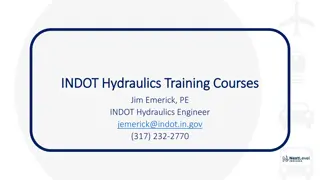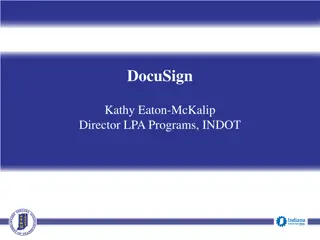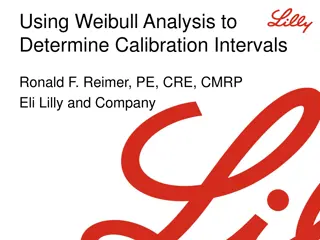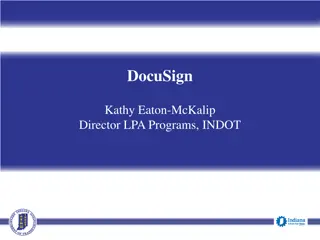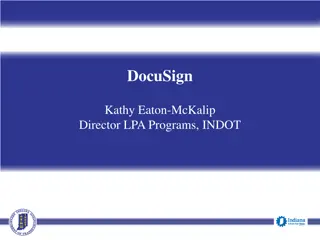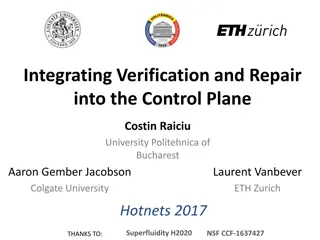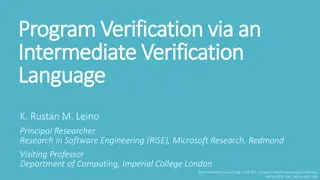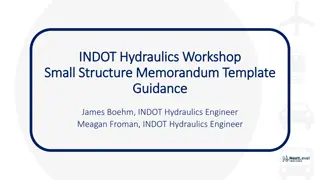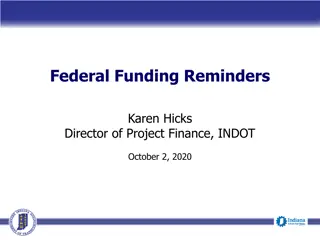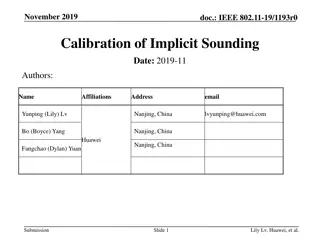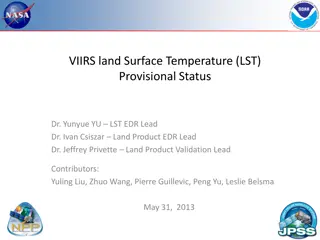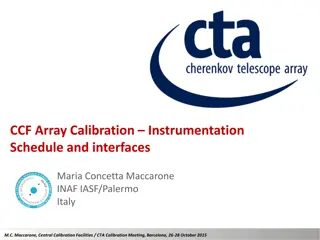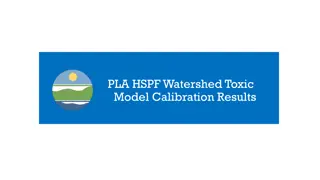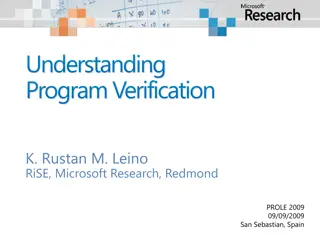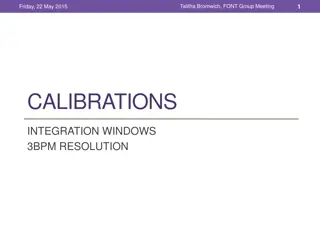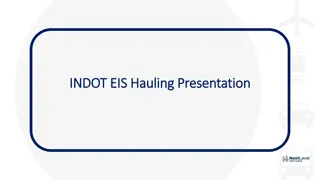Local Calibration and Verification for INDOT - PMED User Group Meeting
This presentation highlights the local calibration and verification process for the Indiana Department of Transportation (INDOT) from Version 2.3 to 2.6. The session covers the objectives, data collection, processing, and analysis conducted by Kumar Dave, Jusang Lee, and Matt Thomas. INDOT's key facts, including its extensive highway network and budget, are also outlined. The initiative includes calibration adjustments, testing, and comparisons between Pavement ME V2.3 and V2.6, culminating in final calibrations and conclusions. The project aims to enhance INDOT's pavement design capabilities effectively.
Download Presentation

Please find below an Image/Link to download the presentation.
The content on the website is provided AS IS for your information and personal use only. It may not be sold, licensed, or shared on other websites without obtaining consent from the author. Download presentation by click this link. If you encounter any issues during the download, it is possible that the publisher has removed the file from their server.
E N D
Presentation Transcript
Local Calibration/Verification for INDOT Local Calibration/Verification for INDOT from Ver 2.3 to 2.6 from Ver 2.3 to 2.6 PMED User Group Meeting September 7, 2023 Kumar Dave, P.E. Jusang Lee, P.E. Matt Thomas, P.E.
Outline Introduction and objective (Kumar Dave) Local calibrations (Jusang Lee) Data collection Data processing Data analysis Calibration adjustments (Matt Thomas) Testing of initial calibrations Pavement ME V2.6 output compared to V2.3 Final calibrations Conclusions/Questions
INDOT Facts INDOT maintains more than 29,600 lane miles (over 11,200 centerline miles) of highways in Indiana. INDOT is responsible for maintaining more than 5,700 bridges across the state. INDOT supports approximately 4,500 rail miles, regulates more than 110 public access airports, and 560 private access airports across the state. Slide 3
Continue. INDOT has approximately 3,500 employees, making it one of the state s largest agencies. INDOT s FY 2022 capital expenditures budget was more than $2.55 billion annually. INDOT s FY 2022 operating budget is approximately $570.6 million annually. Slide 4
Districts Slide 5
Pavement Design 500+ PD/Year PD for all INDOT projects 5 PE S Team CO, Indianapolis, IN
Introduction and Objective Pavement ME Implementation(2010) Calibration/verification initiative(On going) Ver 2.3(2017) Calibration of AASHTO Pavement ME Ver 2.6(2021-23) Local Calibration (Research Project) Jusang Lee Calibration adjustments .. Matt Thomas
Calibration Process JTRP (Joint Transportation Research Program) SPR-4447 Procedural Framework for Local Calibration of AASHTO Pavement ME Version 2.6 using INDOT PMS Test section selections Distress measurement collections Distress predictions Calibration Verification, optimization, and validation Comparison V 2.3 and V 2.6 Recommendations Two sets of calibration coefficients with different scenarios
Test Section Selection INDOT started the MEPDG implementation in 2010. All selected sections were MEPDG-designed pavements. Mini. # of Projects (90% Confidence level) 31 31 38 Available # of Projects 39 39 38 HMA Full-Depth HMA Overlay PCCP HMA Full-Depth 39 Projects HMA Overlay 39 Projects PCCP 38 Projects
Test Section Selection 100 92 80 Interstate Number of Projects 60 36.2 42.2 US-highway 40 21.6 State Road 20 12 10 2 0 AADTT > 20,000 AADTT 3,000 3,000 < AADTT 6,000 6,000 < AADTT 20,000
Distress Measurements INDOT PMS data Collection from 2017, 2018, 2019 Pathway and Pathweb 1/10-mile interval sampling Used average values Data converted to format compatible with input requirements of the Performance Data Calculator (PDC) developed as the part of this project. Trend Graphs CAT Input
Distress Predictions V2.6 INDOT inputs used for V2.3 Traffic inputs: original design documents Climate: MERRA climatic data Material inputs Hybrid-level 1 material inputs for HMA Subgrade inputs from Geotech reports Default calibration factors
Calibration HMA FD Rutting Validated Verification Optimization Validation Bias: 0.13 Bias: 0.00 Bias: 0.00 SE: 0.14 SE: 0.05 SE: 0.04 Pairwise p-value: 0.000 Pairwise p-value: 0.895 Pairwise p-value: 0.680 13
Comparison: 2.6 Global VS. 2.6 Local VS. 2.3 Local HMA FD Rutting (20 years @ 90% Reliability) HMA FD Thermal Cr. (20 years @ 90% Reliability) 14
Recommendations: Two Scenarios Scenario 1 Scenario 2 15
Testing of initial calibrations Designers ran Pavement ME V2.6 for Proposed Recommended Calibrations for Scenario 2 and compared results to outputs we had using ME V2.3. INDOT has been using V2.3 for 6 years. Used Three Traffic Loadings based on truck volumes Low (<3,000 Trucks/day) Medium (3,000 6,000 Trucks/day) High (>6,000 Trucks/day) Ran with Rural and Urban Climatic Stations MERRA Subgrade Treatment (Stabilized soil using cement)
Performance Criteria Reviewed New HMA Pavement and Overlays - IRI - AC Bottom- up Cracking - AC Thermal Cracking - Rutting Permanent Deformation AC only PCCP - IRI - Joint Faulting - Transverse Cracking Ran 50 year runs for full depth pavement, 30 year for overlays
Pavement ME, Why INDOT runs for 50 years INDOT is Alternate Bid State New or Pavement Replacement > 15,000 Syd Design Both HMA and PCCP Calculate the LCPCA (Life Cycle Pavement Cost Analysis) If within 10% then Alternate Bid Structural Life - Pavement ME Design for 50 years Equivalent Structure design for both Pavement Types For HMA Pavement, Bottom-up Cracking below 5% at 35-40 years For PCCP, Cracking below 5% at age 50
Comparison of Recommended Calibration vs Pavement ME V2.3 Full Depth HMA HMA Pavement Thickness MEPDG Version 2.6 Global Calibrations MEPDG Version 2.6 Calibrations based on Scenario 2 (BUC Global) MEPDG Version 2.6 All Local Calibrations Truck Traffic Distress MEPDG Version 2.3 IRI Failed at age 32 Failed at age 26 Failed at age 10 Failed at age 45 Bottom-up Cracking 2.16% at age 50 -passed 2.1% at age 50 -passed 2% at age 50 -passed 1% at age 50 -passed 544 (Low < 3,000) 11 inches Pavement Rutting Below 0.4 inch at age 50 - passed Failed at age 8 Below 0.4 inch at age 50 - passed Below 0.4 inch at age 50 - passed Thermal Cracking Below 500 at age 50 - passed Failed at age 8 Failed at age 3 Failed at age 3 IRI Failed at age 25 Failed at age 18 Failed at age 10 Failed at age 30 Bottom-up Cracking 2.67% at age 50 -passed Failed at age 49 Failed at age 48 1% at age 50 -passed 3,930 (Medium, 3,000 - 6,000) 14 inches Pavement Rutting Below 0.4 inch at age 50 - passed Failed at age 10 Below 0.4 inch at age 50 - passed Below 0.4 inch at age 50 - passed Thermal Cracking Below 500 at age 50 - passed Failed at age 49 Failed from beginning, age 0 Failed at age 3 IRI Failed at age 22 Failed at age 17 Failed at age 10 Failed at age 35 Bottom-up Cracking 5% at age 50 -passed Failed at age 26 Failed at age 27 1% at age 50 -passed 16,932 (high, above 6,000) 16.5 inches Pavement Rutting Below 0.4 inch at age 50 - passed Failed at age 7 Below 0.4 inch at age 50 - passed Below 0.4 inch at age 50 - passed Thermal Cracking Below 500 at age 50 - passed Below 500 at age 50 - passed Below 500 at age 50 -passed Below 500 at age 50 -passed
Bottom-up Cracking and IRI High Traffic Full Depth HMA Pavement ME V2.6 Pavement ME V2.3 IRI Local - IRI Global - IRI Bottom - up Local Bottom - up Global Bottom - up
Initial Testing Results V2.6 PavementME Full Depth PCCP and HMA Rehabilitation Global calibrations matched up better than local for all performance criteria. (Stayed with global) Full Depth HMA IRI matched up better with global calibration then with local for all traffic groups Bottom-up cracking Global calibration - cracking failed early for high traffic group (not acceptable) Local calibration - cracking was under 1% for 50 years design for all traffic groups (not acceptable)
Initial Testing Results FD HMA V2.6 PavementME Rutting Global calibration failed at 7 to 10 years on all Local calibration did not fail before design life (50) for all traffic groups. Thermal cracking Global calibration gave passing or failing year that was similar for medium and high traffic groups (Stayed with global) and Rutting for the full depth HMA Then went back to research for new calibrations on Bottom Up
Comparison of updated Calibration vs Pavement ME V2.3 IRI local and global Full Depth HMA HMA Pavement Thickness MEPDG Version 2.3 Current INDOT use MEPDG Version 2.6.2.2 Global Calibrations MEPDG Version 2.6.2.2 Calibrations (BUC 2.3 -IRI & RUT LC - TC GC) MEPDG Version 2.6.2.2 Calibrations (BUC 2.3 - IRI & TC - GC - RUT LC) Truck Traffic Distress IRI Failed at age 32 Failed at age 26 Failed at age 11 Failed at age 29 Bottom-up Cracking 2.16% at age 50 -passed 1.54 % at age 50 -passed 1.9% at age 50 -passed 1.9% at age 50 -passed 544 (Low < 3,000) 11 inches Pavement Rutting Below 0.4 inch at age 50 - passed Below 0.4 inch at age 50 -passed Below 0.4 inch at age 50 - passed Below 0.4 inch at age 50 - passed Thermal Cracking Below 500 at age 50 - passed Failed at age 3 Failed at age 3 Failed at age 3 IRI Failed at age 25 Failed at age 18 Failed at age 8 Failed at age 22 Bottom-up Cracking 2.67% at age 50 -passed 2.61% at age 50 - passed 2.09 % at age 50 - paased 2.09% at age 50 -passed 3,930 (Medium, 3,000 - 6,000) 14 inches Pavement Rutting Below 0.4 inch at age 50 - passed Below 0.4 inch at age 50 -passed Below 0.4 inch at age 50 - passed Below 0.4 inch at age 50 - passed Thermal Cracking Below 500 at age 50 - passed Below 500 at age 50 - passed Below 500 at age 50 -passed Below 500 at 50 - passed IRI Failed at age 22 Failed at age 17 Failed at age 7 Failed at age 20 Bottom-up Cracking 5% at age 50 -passed Failed at age 38 3.08% at age 50 - paased 3.08% at age 50 -passed 17,000 (high, above 6,000) 16.5 inches Pavement Rutting Below 0.4 inch at age 50 - passed Below 0.4 inch at age 50 -passed Below 0.4 inch at age 50 - passed Below 0.4 inch at age 50 - passed Thermal Cracking Below 500 at age 50 - passed Below 500 at age 50 - passed Below 500 at age 50 -passed Below 500 at age 50 -passed
Updated Calibrations - Bottom-up Cracking and IRI High Traffic Pavement ME V2.3 Pavement ME V2.6 Global - IRI IRI Local Bottom - up Bottom - up
Final Calibrations Pavement ME V2.6 INDOT adopted following calibrations. New HMA Pavement IRI - global Bottom-up cracking updated local Rutting local from original 2.6 study Thermal Cracking global PCCP All global IRI global Faulting global Transverse Cracking global HMA Rehabilitations All global
V2.6 VS. V2.3 using V2.3 Global Calibration Factors (Bottom-up fatigue cracking) Bottom-up Fatigue Cracking at 50% R Bottom-up Fatigue Cracking at 90%R 100 100 V 2.6 with V2.3 Global Calibration Factors V 2.6 with V2.3 Global Calibration Factors 80 80 60 60 R = 0.9731 40 40 R = 0.9815 20 20 0 0 0 20 40 60 80 100 0 20 40 60 80 100 V 2.3 V 2.3



